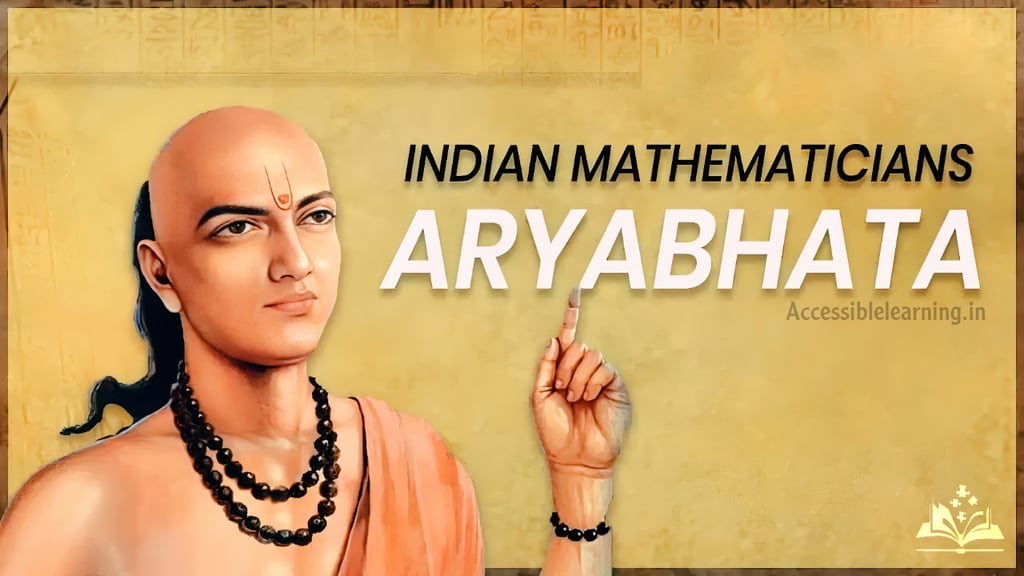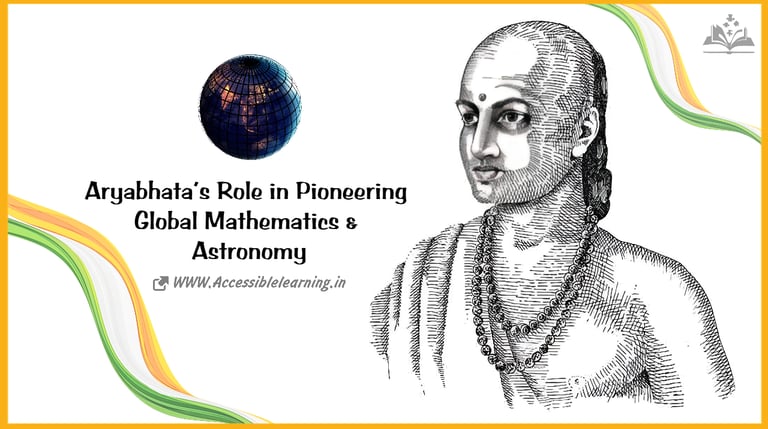
Aryabhata’s Scientific Revolution: How Ancient India Shaped the Modern World?
Aryabhata, an ancient Indian polymath, made groundbreaking contributions to mathematics and astronomy that continue to influence modern science. Known for his revolutionary work in trigonometry, algebra, and the understanding of celestial phenomena, Aryabhata's insights into the universe's mechanics and his development of mathematical principles like the concept of zero and the decimal system laid the foundation for future scientific advancements. This article explores Aryabhata’s life, his key achievements, and his enduring impact on global knowledge.
SCIENCE/PHILOSOPHYINDIAN HISTORYWRITER/POETBIOGRAPHYTHE GREAT LEADER
Sachin K Chaurasiya
1/2/20257 min read


Aryabhata (आर्यभट्ट) Ji (476 CE–550 CE), a trailblazing mathematician and astronomer of ancient India, occupies a revered place in the history of science. His name is synonymous with intellectual brilliance, and his contributions remain monumental in shaping the fields of mathematics and astronomy. As one of the earliest scholars to systematize mathematical concepts and observe celestial phenomena scientifically, Aryabhata's legacy transcends boundaries and time.
Early Life & Education
Though precise details of Aryabhata’s early life remain elusive, it is widely accepted that he was born in 476 CE in Kusumapura (कुसुमपुरा) (modern-day Patna, Bihar). Some historical sources suggest he may have hailed from Kerala or was deeply connected with the South Indian tradition of scholarship. Aryabhata studied and worked in an era when India was a global hub of learning, home to institutions like Nalanda. Kusumapura, where Aryabhata reportedly composed his magnum opus, was a significant center of learning, indicating his affiliation with highly intellectual environments.
Aryabhata’s education reflected the rich tradition of interdisciplinary studies. He was trained in mathematics, astronomy, and Sanskrit, and his works demonstrate a deep understanding of both scientific principles and philosophical inquiry.
Key Contributions to Mathematics!
Aryabhata’s contributions to mathematics are well documented in his seminal work, the Aryabhatiya. Written in Sanskrit verse form, this treatise, divided into four sections, encompasses the essence of ancient Indian mathematics and astronomy.
Introduction of Zero and Place Value?
Aryabhata's conceptualization of the place value system and use of zero were foundational. While the numeral zero was not explicitly used in his notation, the mathematical principles underlying his work paved the way for its formal recognition.
Decimal System and Numerals!
Aryabhata popularized the decimal system, which underpins modern arithmetic. His numeral system, known as the Aryabhata Numeration (आर्यभट्ट अंकगणित), employed letters of the Sanskrit alphabet to represent numbers, an innovative method that combined linguistics and mathematics.
Accurate Approximation of Pi (π)
Aryabhata calculated the value of pi as 62,83220,000\frac{62,832}{20,000}20,00062,832, or 3.1416, and recognized its irrational nature. This approximation was remarkably precise and predated similar findings in Europe by centuries.
Introduction of Trigonometric Concepts
Aryabhata introduced early forms of sine and cosine, referred to as “jya” and “kojya,” respectively. His trigonometric tables and calculations were instrumental in solving astronomical problems, forming the basis of later developments in trigonometry.
Algebra and Indeterminate Equations
Aryabhata worked on solutions for indeterminate equations, particularly the kuttaka (कूटटक) (pulverizer) method, which involves solving equations with multiple variables. This method was pivotal in developing number theory and influenced mathematicians like Brahmagupta and later European scholars.
Quadratic Equations and Progressions
Aryabhata provided systematic techniques for solving quadratic equations and calculating sums of arithmetic progressions. His algebraic methods showed remarkable sophistication for his era.
Aryabhata’s Astronomical Innovations!
Aryabhata Ji’s astronomical observations challenged prevailing myths and laid the foundation for scientific inquiry. His theories demonstrated a profound understanding of celestial mechanics and were far ahead of their time.
Earth’s Rotation
Aryabhata was one of the first scholars to propose that the Earth rotates on its axis, explaining the apparent movement of the sun and stars. This insight was a radical departure from the geocentric models prevalent in many ancient cultures.
Heliocentric Elements
While Aryabhata's cosmology did not fully advocate a heliocentric model, his calculations of planetary motion hinted at an understanding of the Sun's central role in the solar system.
Eclipses
Aryabhata provided scientific explanations for solar and lunar eclipses, attributing them to the shadows cast by celestial bodies. He rejected the notion of supernatural forces causing eclipses, marking a significant shift toward rational and scientific thinking.
Measurement of Time
Aryabhata calculated the length of a sidereal year (365.258 days) with incredible precision, deviating by only a few minutes from modern calculations. He also introduced units of time measurement such as the kalpa (कल्प) (a cosmic cycle), yuga (युग), and smaller divisions like ghatis (घाटियाँ).
Planetary Orbits
Aryabhata described the elliptical paths of planets and their varying speeds, a precursor to later Keplerian theories. He emphasized the mathematical modeling of planetary motion to predict their positions accurately.
The Aryabhatiya
Gitikapada: Discusses time, planetary positions, and units of measurement.
Ganitapada: Focuses on mathematical principles, including geometry and arithmetic.
Kalakriyapada: Addresses astronomical time scales and planetary motion.
Golapada: Elaborates on spherical astronomy and eclipses.


Influence on Global Science!
Aryabhata Ji’s influence extended beyond India, thanks to translations of his work into Arabic during the Islamic Golden Age. His ideas traveled to Europe via Arab scholars, contributing to the Renaissance in mathematics and astronomy. Aryabhata’s impact is visible in the works of later luminaries such as Al-Khwarizmi and Fibonacci.
Aryabhata Ji's Influence on Other Cultures!
Aryabhata Ji's works were not confined to India but had a profound influence on global scientific thought. After his death, his astronomical and mathematical ideas were disseminated across different parts of the world, particularly through translations into Arabic.
Impact on Islamic Scholars
During the Islamic Golden Age, Aryabhata's works, especially the Aryabhatiya, were translated into Arabic. These translations reached scholars like Al-Battani, Al-Khwarizmi, and Avicenna, who integrated Aryabhata’s ideas into their own works. Al-Battani, for instance, made further advancements in trigonometry based on Aryabhata’s work. His work on the computation of trigonometric tables greatly influenced the development of mathematics in the Arab world, which later found its way into Europe.
Western Influence
Aryabhata's work indirectly impacted European scholars such as Fibonacci. Through the work of Arabic mathematicians, Aryabhata's contributions to algebra, number theory, and trigonometry spread to Europe during the Renaissance. Fibonacci's "Liber Abaci" (1202), which introduced the Hindu-Arabic numeral system to Europe, contained mathematical concepts influenced by Aryabhata’s work.
The Transmission of Knowledge
Aryabhata’s works were not only transmitted through Arabic scholars but also influenced mathematical thought in regions like Central Asia and Persia, becoming a central part of the intellectual tradition during the Middle Ages.
Aryabhata’s Mathematical & Astronomical Methods
Aryabhata Ji’s methodologies were based on both empirical observation and advanced reasoning. Here are some important aspects of his mathematical and astronomical methods:
Geometrical Approaches to Trigonometry
Aryabhata’s trigonometric approach was based on geometry, specifically circular motion. His idea of jya (sine) was linked with the half-chord of a circle, which evolved into the modern trigonometric sine function. He calculated the sine values for angles and constructed tables to facilitate astronomical calculations. This was fundamental in his work on the movement of celestial bodies.
Algorithmic Calculations
Aryabhata Ji’s ability to perform complex computations in his head was astonishing. His understanding of algorithms, particularly for calculating squares, square roots, and other fundamental operations, influenced subsequent developments in computational mathematics.
Astronomical Instruments
Although specific instruments are not attributed to Aryabhata, it is believed that he contributed to the design of astronomical instruments used for observing celestial bodies. Aryabhata’s astronomical observations required precision, suggesting that some form of rudimentary instrument, like the gnomon (used for determining the time of day), was utilized.
Kepler’s Laws and Aryabhata
Aryabhata's understanding of planetary motion closely aligns with some elements of Kepler's laws of planetary motion, particularly the idea that planets move in elliptical orbits and that their speed varies based on their position in the orbit. Though Aryabhata didn't fully develop the heliocentric theory, his theories laid the groundwork for later astronomers to explore the Sun-centered model of the solar system.
Aryabhata’s Philosophical and Theological Context!
Aryabhata's work was deeply intertwined with the philosophical and religious context of his time. He was influenced by the ideas of the Vedic and Upanishadic traditions, which focused on the idea of cycles, time, and the infinite.
Connection with the "Cosmic Order"
Aryabhata’s work on time cycles and the calculation of long periods such as the yuga (cosmic age) reveals his philosophical grounding in the idea of cosmic cycles. In Hindu cosmology, time is cyclical, and Aryabhata’s calculations of the length of the solar year and the sidereal year reflect this cyclical understanding of the universe.
Rationalism and Spirituality
Aryabhata's rational approach to astronomy and mathematics was unique for its time, as he often distanced himself from mythological explanations of natural phenomena. While Indian astronomy had a strong influence from religious texts, Aryabhata favored scientific reasoning over theological doctrines in explaining phenomena like eclipses. His work in understanding the movement of the planets demonstrated the influence of both science and philosophy, with an emphasis on reason and evidence over myth.


Aryabhata and the Mathematical Revolution!
Aryabhata’s works marked a pivotal point in the development of mathematics, both in India and globally. His innovations helped catalyze a mathematical revolution in India, which later influenced scholars in the Arab world and Europe.
Algebra and Number Theory
Aryabhata’s work with quadratic equations and indeterminate equations was revolutionary. His use of algorithms for solving these problems laid the foundation for later developments in algebra and number theory. Brahmagupta (ब्रह्मगुप्त) Ji, who followed Aryabhata, made advancements in algebra and provided solutions for quadratic equations, building on Aryabhata’s methods.
Influence on Indian Mathematicians
Aryabhata’s work formed the basis for a rich tradition of mathematical exploration in ancient India, with scholars like Brahmagupta (ब्रह्मगुप्त), Bhaskara I (भास्कर प्रथम), and Bhaskara II (भास्कर द्वितीय) further advancing these ideas. His emphasis on precise calculation and algebraic reasoning laid the intellectual groundwork for later mathematicians to refine and extend the principles.
The Concept of Infinity
Aryabhata’s concept of infinity was also groundbreaking. His work on the infinite series and the calculation of astronomical distances demonstrates that ancient Indian mathematicians understood the vastness of the universe and the concept of infinite progression.
Aryabhata's Mystique: A Symbol of Indian Genius?
Aryabhata Ji’s contributions serve as a beacon of intellectual accomplishment in India’s history. In a time when much of the world relied on mythological explanations for natural phenomena, Aryabhata’s ability to provide logical, evidence-based reasoning made him an anomaly in his age. His works are a testament to the genius of ancient Indian science, and his influence reverberates through the centuries.
Through Aryabhata’s achievements, we are reminded of the potential for human knowledge to bridge cultures and time periods. Today, Aryabhata is not only remembered as a scientific luminary but also as a symbol of India’s rich intellectual history and its contributions to the global understanding of science and mathematics.
Aryabhata’s Legacy
Aryabhata's enduring legacy is celebrated globally. India’s first satellite, launched in 1975, was aptly named Aryabhata to honor his contributions. Statues, educational institutions, and awards in his name ensure that his memory remains alive in modern times.
Aryabhata’s Human Side!
Beyond his intellectual achievements, Aryabhata’s life symbolizes the pursuit of truth and curiosity about the natural world. His work reflects a harmonious blend of empirical observation and theoretical reasoning, making him not only a mathematician and astronomer but also a philosopher-scientist who inspired generations.
Aryabhata was a pioneer who redefined humanity's understanding of mathematics and astronomy. His contributions resonate across disciplines, proving the timeless relevance of his work. As we delve into Aryabhata’s legacy, we honor a mind that dared to explore the unknown and chart a path for future scientific inquiry.
By embracing the spirit of Aryabhata’s discoveries, we celebrate the intellectual heritage of humanity and reaffirm our commitment to exploring the mysteries of the universe.
Subscribe To Our Newsletter
All © Copyright reserved by Accessible-Learning Hub
| Terms & Conditions
Knowledge is power. Learn with Us. 📚


